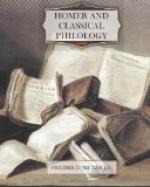So Homer, the poet of the Iliad and the Odyssey, is an aesthetic judgment. It is, however, by no means affirmed against the poet of these epics that he was merely the imaginary being of an aesthetic impossibility, which can be the opinion of only very few philologists indeed. The majority contend that a single individual was responsible for the general design of a poem such as the Iliad, and further that this individual was Homer. The first part of this contention may be admitted; but, in accordance with what I have said, the latter part must be denied. And I very much doubt whether the majority of those who adopt the first part of the contention have taken the following considerations into account.
The design of an epic such as the Iliad is not an entire whole, not an organism; but a number of pieces strung together, a collection of reflections arranged in accordance with aesthetic rules. It is certainly the standard of an artist’s greatness to note what he can take in with a single glance and set out in rhythmical form. The infinite profusion of images and incidents in the Homeric epic must force us to admit that such a wide range of vision is next to impossible. Where, however, a poet is unable to observe artistically with a single glance, he usually piles conception on conception, and endeavours to adjust his characters according to a comprehensive scheme.
He will succeed in this all the better the more he is familiar with the fundamental principles of aesthetics: he will even make some believe that he made himself master of the entire subject by a single powerful glance.




